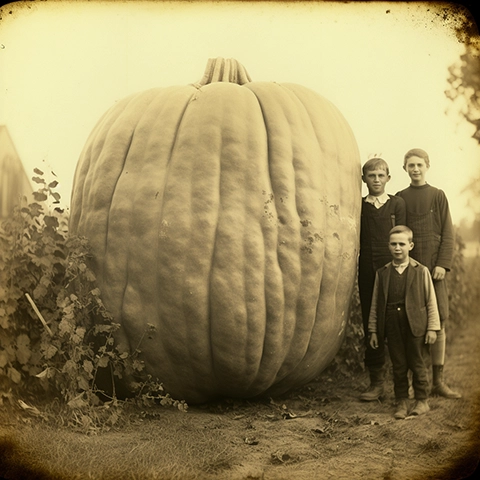In the heart of the rural countryside of Roald Dahl’s beloved hometown, nestled among the rolling hills of Buckinghamshire, there stood a quaint pumpkin farm that, in 1921, would carve its own place in history. The Smith family, known far and wide for their remarkable crop of gargantuan pumpkins, were the proud proprietors of this unique patch of land.
The Smiths, a humble and hardworking family, were a testament to the American dream, despite their location in the heart of England. John and Mary Smith, parents of three lively and imaginative children, carved out a living on their expansive pumpkin farm. The farm had been in the family for generations, but it was in the early 20th century that they embarked on a peculiar and ambitious endeavor – specializing in the cultivation of colossal pumpkins, some of which would dwarf grown adults.
Their story began in the quaint village of Great Missenden, where the Smiths’ farm stretched over acres of picturesque countryside. As visitors approached, they were greeted by an astonishing sight, rows upon rows of pumpkins that seemed more like mountains than mere vegetables. The Smiths’ secret to growing such prodigious pumpkins was closely guarded, and the entire region marveled at their yearly harvest.
What truly set the Smith family apart from their farming peers was an annual tradition that drew people from near and far. Each year, on the first weekend of October, the Smiths would host a pumpkin race that took place in the nearby river. Yes, you heard that correctly – a pumpkin race! The idea was simple but genius; gigantic pumpkins, some weighing as much as a small car, were carefully hollowed out and fitted with floats, allowing them to glide down the river like oversized boats.
This spectacle drew visitors from across the county and even beyond. The small, sleepy village of Great Missenden was transformed into a bustling hub of activity as townsfolk and tourists eagerly awaited the grand event. The Smiths’ annual pumpkin race became the talk of the town and was eagerly anticipated year after year.
Young Roald Dahl, who lived just a stone’s throw away from the Smiths’ farm, was captivated by the event. As a child growing up next to the farm, he witnessed the grandeur and excitement that surrounded the yearly pumpkin race. He would often sneak into the Smiths’ farm to catch a glimpse of the colossal pumpkins and watch the races with wide-eyed wonder.
Little did anyone know that this annual event would later serve as a profound source of inspiration for Dahl. In the years to come, he would craft one of his most enchanting and memorable tales – “James and the Giant Peach.” Dahl’s vivid imagination transformed the colossal pumpkins into an even grander fruit, a colossal peach, setting the stage for an extraordinary adventure. It was the spirit of the Smith family’s pumpkin race that danced through the pages of Dahl’s classic novel, adding a dash of magic to the story of James and his incredible journey.
While Roald Dahl’s masterpiece may have transformed pumpkins into peaches, the legacy of the Smith family’s unusual pumpkin farm endures. Their unique tradition of growing enormous pumpkins and hosting the annual pumpkin race remains etched in the annals of Great Missenden’s history, forever reminding the world that, sometimes, the most extraordinary adventures can be found in the most unexpected places.
In the decades that followed, the Smiths’ farm became a beloved landmark, not just for its mammoth pumpkins but for the enduring sense of wonder and whimsy it brought to the lives of all who had the privilege to experience their unique annual race. As the years passed, the Smith family continued to sow seeds of magic and inspiration in their small corner of the world, proving that the ordinary could indeed be extraordinary with a little imagination and a lot of love.

